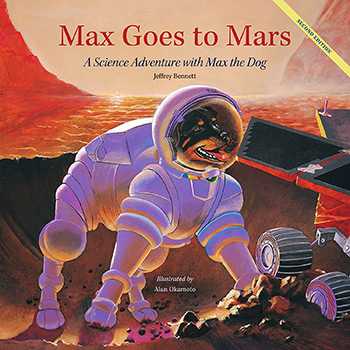Category: Children’s Book
Reviewed by: Marianne Dyson
Title: Max Goes to Mars
Author: Jeffrey Bennett
Illustrator: Alan Okamoto
Reading Level: Ages 4-8
NSS Amazon link for this book
Format: Hardcover
Pages: 32
Publisher: Big Kid Science
Date: 2006
Retail Price: $16.95
ISBN: 0972181911
After his successful trip to the Moon, Max the dog joins a crew searching for life on Mars. Before his trip, his owner, a young woman named Tori, tells him all about the planet. Max and his crew take advantage of advanced propulsion to reach Mars in four months. They set up a base camp and then explore canyons and volcanoes. Max makes a big discovery, and returns home a hero about two years after he left.
In addition to the main story, every page of Max Goes to Mars includes a sidebar with more data on the topic discussed by the characters. These sidebars on previous missions, names, fantasies, water, etc. provide answers to many questions older children may ask, and facts such as Tuesday being Mars day that are fun to know and share with others. Author Jeffrey Bennett has a Ph.D. in astrophysics from the University of Colorado, Boulder, and meticulously checked these facts. It was a joy to not find any errors! Because younger children may get “sidetracked” into discussions by these sidbars (that are at a higher reading level than the story text), parents may want to save them for a second or third reading of the book.
Alan Okamoto’s colorful art enhances the text and reveals Max’s playful character through his actions such as watching a squirrel in the park and licking a spilled soda in the museum. Space purists may notice that a bit of artistic license is taken on page 14 when a full Earth and Moon are shown in the window behind a crewmember on her way to Mars. Otherwise the images, especially the sky colors (that are explained in a sidebar) are realistic and as scientifically-accurate as the text. The very last page of the book is a heart-warming photo gallery of the real Max.
An interesting idea that should help calm children’s fears of “War of the Worlds” in reverse, is the book’s use of lunar quarantine for the crew returning from Mars. Max and the crew spend three months on the Moon before being allowed to return to Earth to prevent the spread of any Martian microbes. The Martian samples are stored on the Moon where there is no risk of contamination.
An activity included in the back of the book has children demonstrate the retrograde movement of Mars through the constellations. This is an excellent activity for older children with clear diagrams showing how it works. Younger children may lack the background concept of observing objects relative to each other and not fully understand what is being demonstrated, but should still benefit from early exposure to using models to solve problems.
The author explains in a sidebar that though it is unlikely that a dog will be included on a first Martian crew, “it’s not a completely ridiculous idea.” He argues that dogs could certainly provide entertainment and comfort to the crew. Maybe a spacesuit as shown in the story could be adapted to take advantage of a dog’s special ability to smell things humans and machines can’t sense. Whether it is human or canine, most space enthusiasts would agree that using life to search for life makes good sense and increases the chance of success.
Max Goes to Mars is a fun and educational story that all future Martians are sure to enjoy.
© 2006 Marianne Dyson
NSS Featured Review for November 2006
Please use the NSS Amazon Link for all your book and other purchases. It helps NSS and does not cost you a cent! Bookmark this link for ALL your Amazon shopping!



















